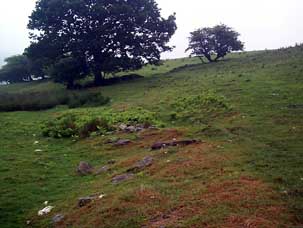Historic Landscape
Characterisation
Merthyr Tydfil
076 Taff Bargoed
HLCA 76 Taff Bargoed Enclosed landscape of medieval and post-medieval fields, possibly containing fossilised prehistoric elements; evolved/irregular field pattern; field boundaries mostly dry-stone wall and stone-faced banks; remnants of mining features and industrial railway. Extent of enclosure during post-medieval period as indicated by cartographic evidence. Dry-stone walls and stone-faced banks (cloddiau).
Summary
An enclosed agricultural landscape along the Taff Bargoed valley, characterised by irregular field patterns, dry stone walls and stone-faced banks, with minor industrial features (mining and associated transport).
Historical background
The historic landscape area of Bargoed Taf primarily comprises an agricultural enclosed landscape of dry-pasture with extensive drystone enclosure boundaries. The field boundaries are for the most part dry-stone wall and stone-faced bank mostly with hedge, although earth bank, ditches and post and wire fence are also present. The drystone boundaries in place by the post-medieval period were probably established during the medieval period and are likely to preserve earlier elements, possibly of prehistoric date. The place-names in the area, Bryn Cyriawg (the later Bryn Caerau) and Nant-y-Ffin probably refer to nearby administrative boundaries. The field system is associated today with post-medieval settlement, including the farmsteads of Bryn Caerau, Cwm Bargoed and Nant-y-Ffin, which are grouped together at the head of the valley and the confluence of the three main tributaries of the valley: the Bargoed Taf itself, Nant Gyrawd, and Nant-y-Ffin.
While 19th century industrial extraction is represented in the area; mining remains, such as levels, tips, ventilation shaft and tramroads, have had a minor impact on the earlier agricultural landscape and are generally small scale.
